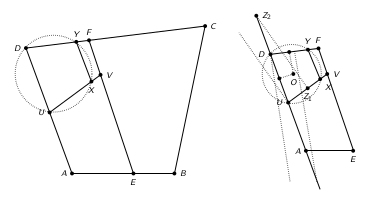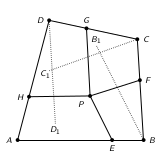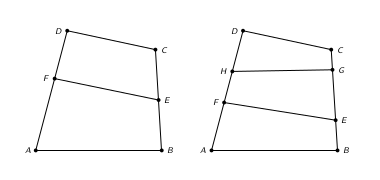1972 IMO Problems/Problem 2
Contents
Problem
Prove that if ![]() , every quadrilateral that can be inscribed in a circle can be dissected into
, every quadrilateral that can be inscribed in a circle can be dissected into ![]() quadrilaterals each of which is inscribable in a circle.
quadrilaterals each of which is inscribable in a circle.
Solution
Our initial quadrilateral will be ![]() .
.
For ![]() , we do this:
, we do this:
Take ![]() with
with ![]() sufficiently close to
sufficiently close to ![]() respectively. Take
respectively. Take ![]() such that
such that ![]() is an isosceles trapezoid, with
is an isosceles trapezoid, with ![]() close enough to
close enough to ![]() (or
(or ![]() close enough to
close enough to ![]() ) that we can find a circle passing through
) that we can find a circle passing through ![]() (or
(or ![]() ) which cuts the segments
) which cuts the segments ![]() in
in ![]() . Our four cyclic quadrilaterals are
. Our four cyclic quadrilaterals are ![]() .
.
For ![]() we do the exact same thing as above, but now, since we have an isosceles trapezoid, we can add as many trapezoids as we want by dissecting the one trapezoid with lines parallel to its bases.
we do the exact same thing as above, but now, since we have an isosceles trapezoid, we can add as many trapezoids as we want by dissecting the one trapezoid with lines parallel to its bases.
The above solution was posted and copyrighted by grobber. The original thread for this problem can be found here: [1]
Remarks (added by pf02, March 2025)
The construction described in the solution above is correct (in the sense that it describes a legitimate way of dissecting an inscribable quadrilateral into four inscribable quadrilaterals). However, the solution is incomplete and sloppily written.
Below I will discuss and complete the solution given above.
Then, I will give a second solution. And finally, I will
discuss the cases when ![]() .
.
Discussion and completion of the above solution
The first issue is the fact that a construction is described, but there is no proof, not even a hint, why the quadrilaterals are inscribable. This is not obvious, and it needs a proof. I will give the proof below.
The second issue is the vagueness of "close enough" used twice
in the proof. The first time it is used, "![]() sufficiently
close to
sufficiently
close to ![]() respectively" is not needed (indeed, any segment
respectively" is not needed (indeed, any segment
![]() parallel to
parallel to ![]() would do), so there is no need to make
this more precise. The second time it is used, namely "
would do), so there is no need to make
this more precise. The second time it is used, namely "![]() close enough to
close enough to ![]() (or
(or ![]() close enough to
close enough to ![]() ) that we can
find a circle passing through
) that we can
find a circle passing through ![]() (or
(or ![]() )" is indeed
needed, and it is not at all clear what "close enough" should
be, or that this is at all possible. I will come back to this
shortly.
)" is indeed
needed, and it is not at all clear what "close enough" should
be, or that this is at all possible. I will come back to this
shortly.
The third issue is poor wording. We don't need to "add as many trapezoids as we want". We want to dissect the one isosceles trapezoid into as many isosceles trapezoids as we want by lines parallel to its bases.
Before giving the missing details, let us remember that a quadrilateral
![]() is inscribable if and only if a pair of opposing angles adds
up to
is inscribable if and only if a pair of opposing angles adds
up to ![]() in other words
in other words ![]() or equivalently,
or equivalently,
![]() . In particular, any isosceles trapezoid is
inscribable.
. In particular, any isosceles trapezoid is
inscribable.
Now let us show that the four quadrilaterals are inscribable. It is easy
to see that the first one, ![]() is inscribable. Indeed,
is inscribable. Indeed,
![]() . We know that
. We know that ![]() because
of parallelism, so
because
of parallelism, so ![]() . The second one,
. The second one, ![]() is an isosceles trapezoid by the choice of
is an isosceles trapezoid by the choice of ![]() , so it is inscribable.
The third one,
, so it is inscribable.
The third one, ![]() is inscribable by construction. It remains to be
shown that
is inscribable by construction. It remains to be
shown that ![]() is inscribable.
is inscribable.
We have ![]() . This shows that
. This shows that ![]() is inscribable.
is inscribable.
Note that as suggested by the solution, we could have chosen ![]() so
that
so
that ![]() is inscribable, in which case a similar argument would have
shown that
is inscribable, in which case a similar argument would have
shown that ![]() is inscribable as well.
is inscribable as well.
Let us now make precise what it means that ![]() should be close enough
to
should be close enough
to ![]() , or
, or ![]() should be close enough to
should be close enough to ![]() , so that we can find
, so that we can find ![]() ,
so that
,
so that ![]() is inscribable.
is inscribable.
Let us assume that ![]() and
and ![]() are acute.
One way of constructing the circle
are acute.
One way of constructing the circle ![]() is the following: Pick
is the following: Pick ![]() on
on
![]() , pick
, pick ![]() on
on ![]() , and find the center
, and find the center ![]() of the circle
of the circle ![]() as
the intersection of the medians to
as
the intersection of the medians to ![]() and
and ![]() . Take
. Take ![]() to be the
intersection of this circle with
to be the
intersection of this circle with ![]() . We want to show that we can
choose
. We want to show that we can
choose ![]() and
and ![]() so that
so that ![]() will be between
will be between ![]() and
and ![]() .
.
Let us consider the median of ![]() . This median intersects
. This median intersects ![]() someplace
on the same side of
someplace
on the same side of ![]() as
as ![]() . Let us pick
. Let us pick ![]() between
between ![]() and this point.
This is the first condition for
and this point.
This is the first condition for ![]() being close enough to
being close enough to ![]() . This
choice ensures that the midpoint of
. This
choice ensures that the midpoint of ![]() is in the region which is the
strip between the median to
is in the region which is the
strip between the median to ![]() and the perpendicular to
and the perpendicular to ![]() at
at ![]() .
.
Now consider ![]() , the median to
, the median to ![]() , and the perpendicular to
, and the perpendicular to ![]() at
at ![]() . We want to make sure that
. We want to make sure that ![]() is chosen so that the midpoint
of
is chosen so that the midpoint
of ![]() is in the region which is the strip between these two lines.
For this, let us take
is in the region which is the strip between these two lines.
For this, let us take ![]() to be the midpoint of
to be the midpoint of ![]() and
and ![]() be the
intersection of the median to
be the
intersection of the median to ![]() with
with ![]() . From the triangle
. From the triangle
![]() , we have
, we have ![]() ,
so
,
so ![]() . In order
to satisfy the condition about the midpoint of
. In order
to satisfy the condition about the midpoint of ![]() , it is enough to
have
, it is enough to
have ![]() . This translates to
. This translates to
![]() . Note that
. Note that ![]() is of fixed slope
and length because
is of fixed slope
and length because ![]() has to be an isosceles trapezoid, so this is
a second condition expressing how close
has to be an isosceles trapezoid, so this is
a second condition expressing how close ![]() has to be to
has to be to ![]() .
.
With this choice of ![]() , the midpoint of
, the midpoint of ![]() is in the region which is
the intersection of the two strips. Now pick
is in the region which is
the intersection of the two strips. Now pick ![]() close enough to
close enough to
![]() , so that the intersection
, so that the intersection ![]() of the medians of
of the medians of ![]() and
and ![]() is in
the same region. (
is in
the same region. (![]() has to be close enough to the foot of the
perpendicular from the midpoint of
has to be close enough to the foot of the
perpendicular from the midpoint of ![]() to
to ![]() .) This ensures that the
circle of center
.) This ensures that the
circle of center ![]() and radius
and radius ![]() will intersect
will intersect ![]() at a
point
at a
point ![]() between
between ![]() and
and ![]() .
.
In the discussion above, we assumed ![]() and
and ![]() to be
acute. The cases when either of these angles is not acute can be dealt
with in a similar way. We will skip the discussion for these cases,
and leave it to the interested reader to work out the details.
to be
acute. The cases when either of these angles is not acute can be dealt
with in a similar way. We will skip the discussion for these cases,
and leave it to the interested reader to work out the details.
Solution 2
First, let us remember that a quadrilateral ![]() is inscribable if
and only if a pair of opposing angles adds up to
is inscribable if
and only if a pair of opposing angles adds up to ![]() in other words
in other words
![]() or equivalently,
or equivalently, ![]() .
In particular, any isosceles trapezoid is inscribable.
.
In particular, any isosceles trapezoid is inscribable.
Let us assume that ![]() is less or equal than all the other angles.
We can assume this because otherwise, we would just need to re-label the
vertices.
is less or equal than all the other angles.
We can assume this because otherwise, we would just need to re-label the
vertices.
Choose a point ![]() inside
inside ![]() , and draw the parallel
, and draw the parallel ![]() to
to ![]() , with
, with ![]() . There will be restrictions on the
position of
. There will be restrictions on the
position of ![]() , which we will discuss as we do the construction.
, which we will discuss as we do the construction.
Choose ![]() so that
so that ![]() is an isosceles trapezoid. In
order for this to be possible,
is an isosceles trapezoid. In
order for this to be possible, ![]() has to be inside the angle
has to be inside the angle
![]() formed by drawing the line
formed by drawing the line ![]() such that
such that
![]() .
.
Next, choose ![]() so that
so that ![]() . This
will ensure that
. This
will ensure that ![]() is inscribable because
is inscribable because
![]() . In order for
. In order for ![]() to exist in
to exist in ![]() ,
,
![]() has to be inside the angle
has to be inside the angle ![]() formed by drawing the line
formed by drawing the line
![]() such that
such that ![]() .
.
Next choose ![]() such that
such that ![]() . This will
ensure that
. This will
ensure that ![]() is an isosceles trapezoid because
is an isosceles trapezoid because
![]() . In order for
. In order for ![]() to
exist in
to
exist in ![]() ,
, ![]() has to be inside the angle
has to be inside the angle ![]() formed by drawing the line
formed by drawing the line ![]() such that
such that
![]() .
.
With these choices, it is easy to see that ![]() is inscribable.
Indeed,
is inscribable.
Indeed, ![]() , and
, and
![]() .
.
We now just have to show that the intersection of the interiors
of angles ![]() is not
is not
![]() . This follows immediately from noticing that
. This follows immediately from noticing that
![]() .
.
We now proceed by induction on ![]() . For
. For ![]() we dissected
the inscribable quadrilateral
we dissected
the inscribable quadrilateral ![]() in two inscribable
rectangles, and
in two inscribable
rectangles, and ![]() isosceles trapezoids. Assume
we dissected the inscribable quadrilateral
isosceles trapezoids. Assume
we dissected the inscribable quadrilateral ![]() in two
inscribable rectangles, and
in two
inscribable rectangles, and ![]() isosceles trapezoids.
Then we dissect one of the isosceles trapezoids in two
isosceles trapezoids by a line parallel to the bases, thus
obtaining the statement for
isosceles trapezoids.
Then we dissect one of the isosceles trapezoids in two
isosceles trapezoids by a line parallel to the bases, thus
obtaining the statement for ![]() .
.
[Solution by pf02, March 2025]
Discuss the problem for n = 2, 3
I will only sketch proofs for these cases.
The case n = 2
In general, an inscribable quadrilateral can not be dissected
into two inscribable quadrilaterals. In fact, the inscribable
quadrilateral ![]() can be dissected into two inscribable
quadrilaterals if and only if
can be dissected into two inscribable
quadrilaterals if and only if ![]() is an isosceles trapezoid.
is an isosceles trapezoid.
To see this, assume we draw ![]() as in the figure below, such
that
as in the figure below, such
that ![]() is inscribable.
is inscribable.
It follows that ![]() , so
, so
![]() . Similarly, if
. Similarly, if ![]() were inscribable, we
would have
were inscribable, we
would have ![]() . So
. So ![]() would be a trapezoid.
Being inscribable, it would have to be isosceles.
would be a trapezoid.
Being inscribable, it would have to be isosceles.
The case n = 3
This can be done, i.e. an inscribable quadrilateral can be
dissected on three inscribable quadrilaterals. To see this,
take ![]() and
and ![]() (equivalently,
these say that
(equivalently,
these say that ![]() are inscribable. It follows
that
are inscribable. It follows
that ![]() is inscribable as well. Indeed,
is inscribable as well. Indeed,
![]() .
.
![]() : This splitting does not yield an inductive
method for
: This splitting does not yield an inductive
method for ![]() . For that, we still need to prove the
case
. For that, we still need to prove the
case ![]() .
.
See Also
| 1972 IMO (Problems) • Resources | ||
| Preceded by Problem 1 |
1 • 2 • 3 • 4 • 5 • 6 | Followed by Problem 3 |
| All IMO Problems and Solutions | ||












